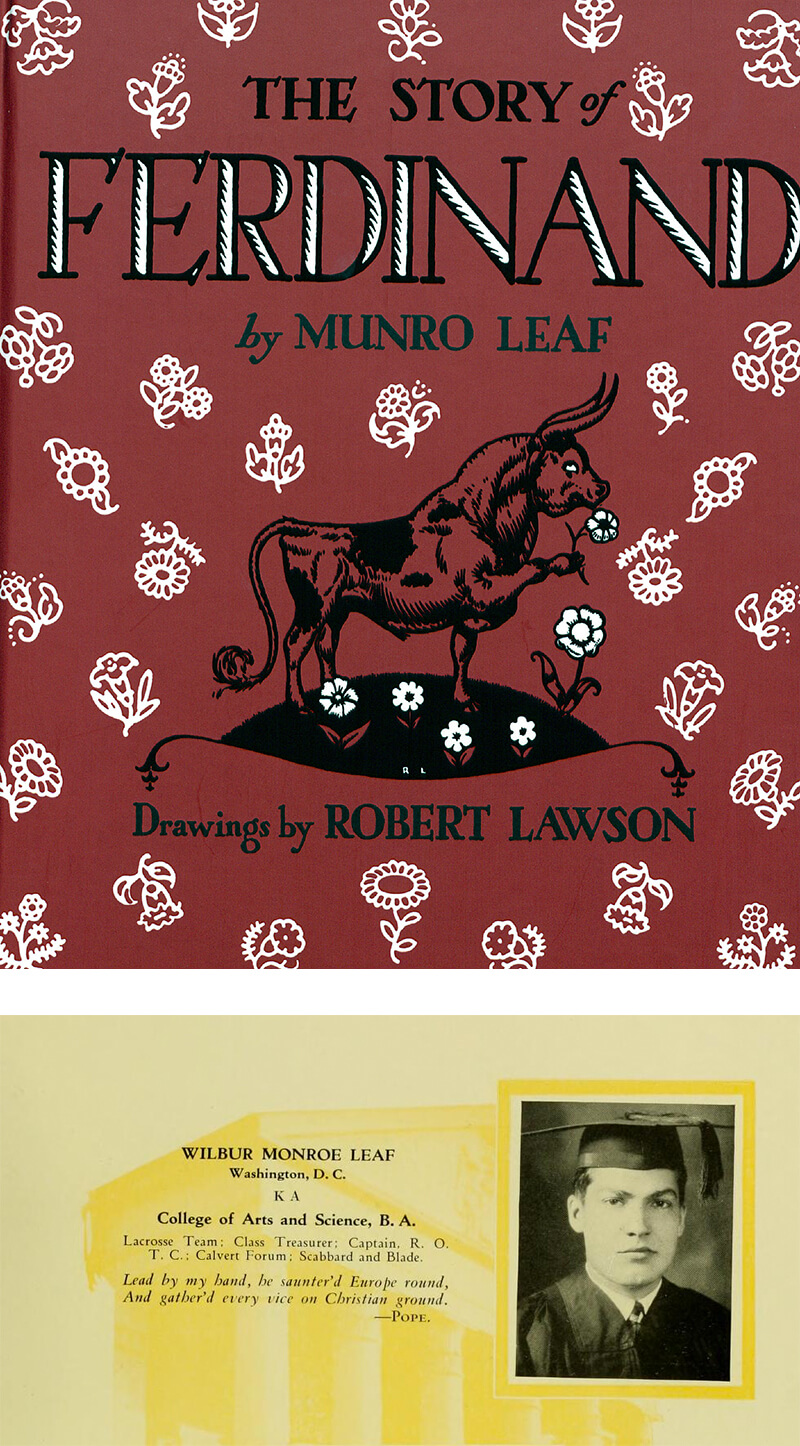- December 12, 2017
- By Kimberly Marselas
A simple bee sting catapulted a peaceful, flower-sniffing bull named Ferdinand into an uncharacteristic rage and sent his creator, author Munro Leaf ’27, soaring to fame.
“The Story of Ferdinand,” Leaf’s 1936 children’s book about a Spanish bull that didn’t want to fight, was simultaneously criticized as pacifist, communist and fascist during the Spanish Civil War and the buildup to World War II. But in the U.S.—and later the world—the simple story illustrated by Robert Lawson went on to sell millions. It has never gone out of print.
This week, Ferdinand will get new life in a new big-screen adaptation by that name, featuring the voices of John Cena and Kate McKinnon. What is it about this fable that has appealed to generations of readers?
Children’s literature scholar Sharon McQueen says it’s because we see Ferdinand as an individual choosing his own path.
 “It is ironic that Leaf’s two best-selling books were published in 1936—“The Story of Ferdinand” and “Manners Can Be Fun”—for one book succeeds, in large part, due to the public’s love of individualism, and the other due to the public’s desire for conformity,” she says. “One theme or the other tends to dominate in many of the books Leaf wrote over his lifetime.”
“It is ironic that Leaf’s two best-selling books were published in 1936—“The Story of Ferdinand” and “Manners Can Be Fun”—for one book succeeds, in large part, due to the public’s love of individualism, and the other due to the public’s desire for conformity,” she says. “One theme or the other tends to dominate in many of the books Leaf wrote over his lifetime.”
In the former, Leaf has Ferdinand sent to a bullfighting ring after he’s seen bucking and snorting from the bee sting; there, he sits to smell the flower scents wafting from ladies’ hats and ignores the matador. Despite being burned by the Nazis and banned in Spain until the 1970s, “Ferdinand” found its way into print some 200,000 times by the time Disney first colorized him for a cartoon short in 1938.
Life magazine described the Oscar-winning version of Ferdinand as a “completely charming creature with a benign white nose who threatens to supplant Mickey Mouse.” He appeared on cereal boxes, on clothing and as a balloon in the Macy’s Thanksgiving Day Parade.
Seventy years later, McQueen wrote her dissertation on Leaf, spending time in the University of Maryland Archives to understand the man behind the bovine legend. In her lectures on Leaf, she praises the book as a classic of peace literature—one whose star has been co-opted as a subversive symbol in everything from political drawings to celebrity tattoos.
But the story of Leaf’s own life tends to contradict that interpretation. Born in Baltimore and raised in Washington, D.C., Leaf earned a bachelor of arts degree at the University of Maryland, where he played lacrosse, boxed and served as a captain for the campus ROTC and senior class treasurer. He then completed a master’s degree at Harvard, where he also won a boxing title.
He worked as a teacher and coach before heading to New York during the Great Depression in search of work as a manuscript reader. (Somewhere along the way, he lost the “e” in Munroe.)
Leaf was no pacifist. He scoffed at the idea of his book being a tool for any regime.
“It was propaganda all right, but propaganda for laughter only,” he’s quoted widely as saying in the late 1930s.
Leaf had the last laugh when “The Story of Ferdinand” pushed “Gone With the Wind” from the top of the bestseller list at the end of 1938.
He went on to serve as a major in the U.S. Army, where he co-wrote an unorthodox military manual on malaria (illustrated by the soon-to-be-famous Dr. Seuss). After being discharged, he continued working for the government, where he wrote political pamphlets supporting the postwar Marshall Plan and later served as a cultural ambassador to Asia. In 1968, he wrote a speech honoring Dean Rusk, the U.S. secretary of state under Kennedy and Johnson and an architect of the Vietnam War.
During all those years, Ferdinand, with its iconic red, flowered cover, remained an early childhood favorite.
 Anne Daniel is assistant director of the university’s Center for Young Children. She previously taught children’s literature in the College of Education for 17 years and often included “The Story of Ferdinand” along with enduring classics like “The Tale of Peter Rabbit” and “Curious George.”
Anne Daniel is assistant director of the university’s Center for Young Children. She previously taught children’s literature in the College of Education for 17 years and often included “The Story of Ferdinand” along with enduring classics like “The Tale of Peter Rabbit” and “Curious George.”
“This book has stood the test of time,” Daniel says. “The text is simple. The simple illustrations are focused, not cluttered.”
She said the story remains relevant in an era when children are inundated with aggressive characters on television and in video games. He’s a character they can empathize with and learn from as he refuses to fight the matador.
“Young children … will understand that Ferdinand is different, that it is OK to be different, and that he is happy being just who he is,” Daniel says. “The message (in the movie) may be the same. Will the ‘heart’ be there? We’ll find out.”
